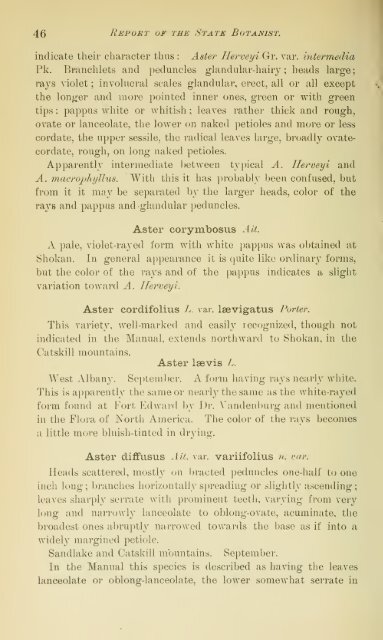Annual Report of the State Botanist 1892 - MykoWeb
Annual Report of the State Botanist 1892 - MykoWeb
Annual Report of the State Botanist 1892 - MykoWeb
Create successful ePaper yourself
Turn your PDF publications into a flip-book with our unique Google optimized e-Paper software.
46<br />
<strong>Report</strong> <strong>of</strong> <strong>the</strong> <strong>State</strong> <strong>Botanist</strong>.<br />
indicate <strong>the</strong>ir character thus : Aster Herveyi Gr. var. intermedia<br />
Pk. Branchlets and peduncles glandular-hairy ; heads large<br />
rays violet ; involucral scales glandular, erect, all or all except<br />
<strong>the</strong> Ioniser and more pointed inner ones, green or with green<br />
tips ; pappus white or whitish ; leaves ra<strong>the</strong>r thick and rough,<br />
ovate or lanceolate, <strong>the</strong> lower on naked petioles and more or less<br />
cordate, <strong>the</strong> upper sessile, <strong>the</strong> radical leaves large, broadly ovate-<br />
cordate, rough, on long naked petioles.<br />
Apparently intermediate l)etween typical A. Herveyi and<br />
A. macrophyllus. With this it has probably been confused, but<br />
from it it may be separated b}' <strong>the</strong> larger heads, color <strong>of</strong> <strong>the</strong><br />
rays and pappus and glandular peduncles.<br />
Aster corymbosus Alt.<br />
A pale, violet-rayed form with white pappus was obtained at<br />
Shokan. In general appearance it is quite like ordinary forms,<br />
but <strong>the</strong> color <strong>of</strong> <strong>the</strong> rays and <strong>of</strong> <strong>the</strong> pappus indicates a slight<br />
variation toward A. Herveyi.<br />
Aster cordifolius L. var, laevigatas Porter.<br />
This variety, well-marked and easily recognized, though not<br />
indicated in <strong>the</strong> Manual, extends northward to Shokan, in <strong>the</strong><br />
Catskill mountains.<br />
Aster laevis L.<br />
West Albany. Septemljer. A form having rays nearly white.<br />
This is apparently <strong>the</strong> same or nearly <strong>the</strong> same as <strong>the</strong> white-rayed<br />
form found at Fort Edward l^y Dr. Vanden'burg and mentioned<br />
in <strong>the</strong> Flora <strong>of</strong> Xorth America. The color <strong>of</strong> <strong>the</strong> rays becomes<br />
a little more bluish-tinted in drying.<br />
Aster diffusus Ait. var. variifolius n. oar.<br />
Heads scattered, mostl}' on bracted peduncles one-half to one<br />
inch long; branches horizontally spreading or slightly ascending;<br />
leaves sharply serrate with prominent teeth, varying from very<br />
long and narrowly lanceolate to oblong-ovate, acuminate, <strong>the</strong><br />
broadest ones abruptly narrowed towards <strong>the</strong> base as if into a<br />
widely margined petiole.<br />
Sandlake and Catskill mountains. September.<br />
In <strong>the</strong> Manual this species is described as having <strong>the</strong> leaves<br />
lanceolate or oblong-lanceolate, <strong>the</strong> lower somewhat serrate in<br />
;
















